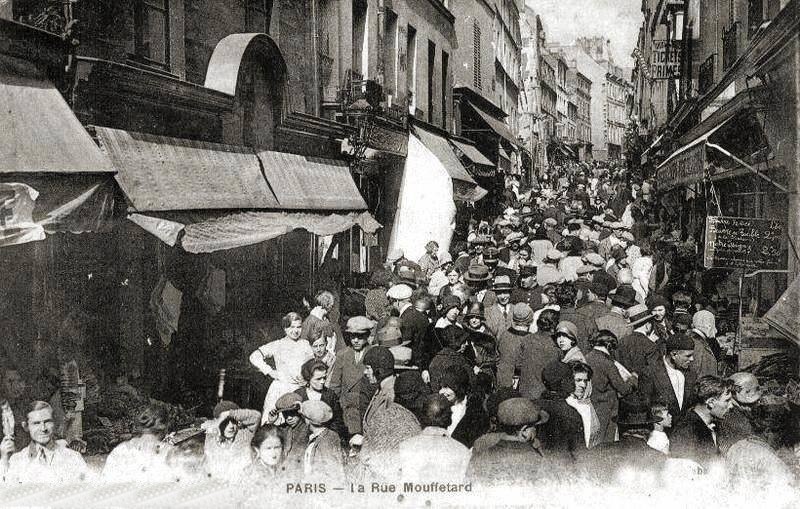An extract from Chapter 2 of ‘Orwell in Paris – Down & Out with the Russain Captain’.
We follow over Eric Blair’s shoulder in 1928 as he discovers the local streets around his hotel.
The rue Mouffetard was at once the main artery and vein of the neighbourhood. It ran from the Square Saint Médard at the foot of the hill all the way up to the Place de la Contrescarpe at the top with tiny passages and smaller streets flowing off and trickling in like tributaries. The everyday life of the quarter depended on this flow and on the shops and bars that lined its cobbled route. While the commerce was varied it mainly kept to the immediate needs of the local population.
Whenever Eric left his hotel on the rue du Pot de Fer and turned right down the rue Mouffetard he would first have passed Madame Cartier’s shop selling herbs and wine, followed by Guignaré and Couderc who sold shoes and wine and then the Bourgoin’s family-run tobacco and wine shop. It was a pattern that repeated itself many times down the street. In the modern era every second establishment seems to offer coffee in one form or another and in 1920s Paris, shops bolstered sales of their own speciality with that of wine. A fruit seller and another wine depot later, the already not very wide street narrowed further and the army barracks that ran like a single block of stone on the left came to an end allowing more stores to display their wares. On the corner, Monsieur Rabat sold sacks of coal (and wine) to the locals and also several of the hotels on the street.
Three doors down on the left hand-side Eric passed Albert Posso and his son who ran a small mechanics workshop mainly specialised in motorbikes but willing to fix anything from hand carts to oil lamps for a fee. Opposite at number 76, squashed in between a milliner and a jeweller was the Maison Pour Tous, a charitable organisation that promoted literacy and also ran a cinema along strict Catholic censorship lines. Further down at number 83 was the only hairdresser on the street. They got much of their trade from the patrons of the slightly up-market Hôtel du Lion D’Or and the Hôtel de l’Esperance standing together opposite.
Then came some of the essentials of French life: the widow Manbourguet ran a creamery selling cheese, eggs and milk, the Fanvin family had a modest patisserie and at number 103 the ubiquitously named Monsieur Dupont was one of the only butchers on the street not to offer horse meat. Eric walked past half a dozen shops selling ladies’ apparel but only one where he could have bought a shirt for himself had his wallet allowed. Despite the lack of space, most shops spilled out onto the street, the goods hanging from awnings and sacks of produce stretching city laws on allocated pavement space. A trestle table full of glass jars containing preserved vegetables overlapped next door’s baskets of dried flowers and also the previous establishment’s selection of knives that were guaranteed to stay sharp three times longer than the competition’s.
From the crossroads with the rue de l’Arbalette, Eric could see all the way to the square at the bottom of the street where horse-drawn carts and motorised delivery vans congregated the time it took for their goods to be transferred onto hand carts and the backs of porters who then ferried them up the hill. As he passed number 119 he encountered a smell that his later travels in the north of England would make him more familiar with than he perhaps ever wanted to be. The vapours from the Pellegrain’s tripe shop mingled with those of the fishmongers and the charcuterie in the same block that formed part of the church enclosure. After a final general store, the run of shops selling essentials repeated itself one last time until Mademoiselle Michelle’s pharmacy on the corner of the rue Pascal signaled the end of the rue Mouffetard and of Eric’s immediate downhill world. One more step would have taken him onto boulevards, avenues and into another way of life; one with different concerns where people vied for space in an increasingly motorised city.
The image is a postcard from 1930 that shows the rue Mouffetard on market day.
The real people & places from Down and Out in Paris and London are revealed in the forthcoming book, Orwell in Paris – Down & Out with the Russian Captain.
To be published first in French: Orwell à Paris – Dans la dèche avec le capitaine russe. By EXILS éditions, Paris on the 24/04/2024
Share this:
Tags: 1928, 1929, down and out, Eric Blair, George Orwell, Mouffetard, orwell, paris, pot de fer
